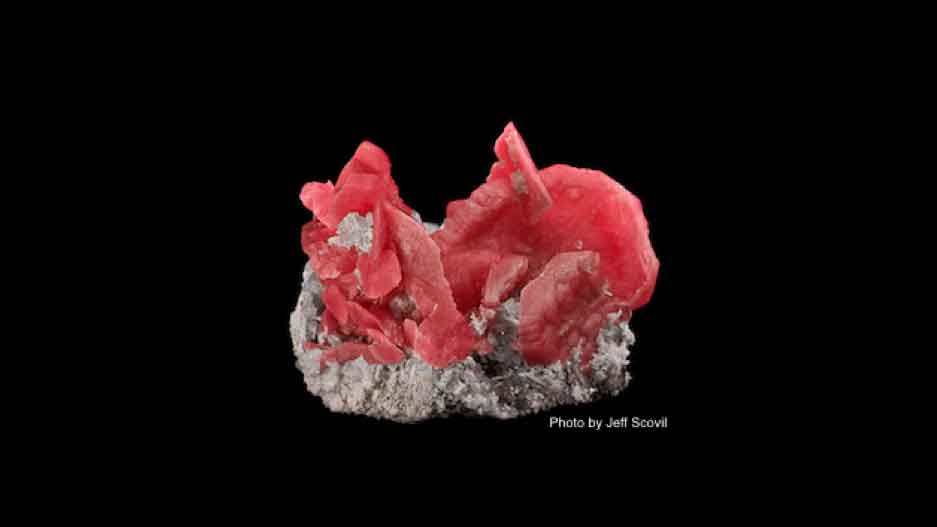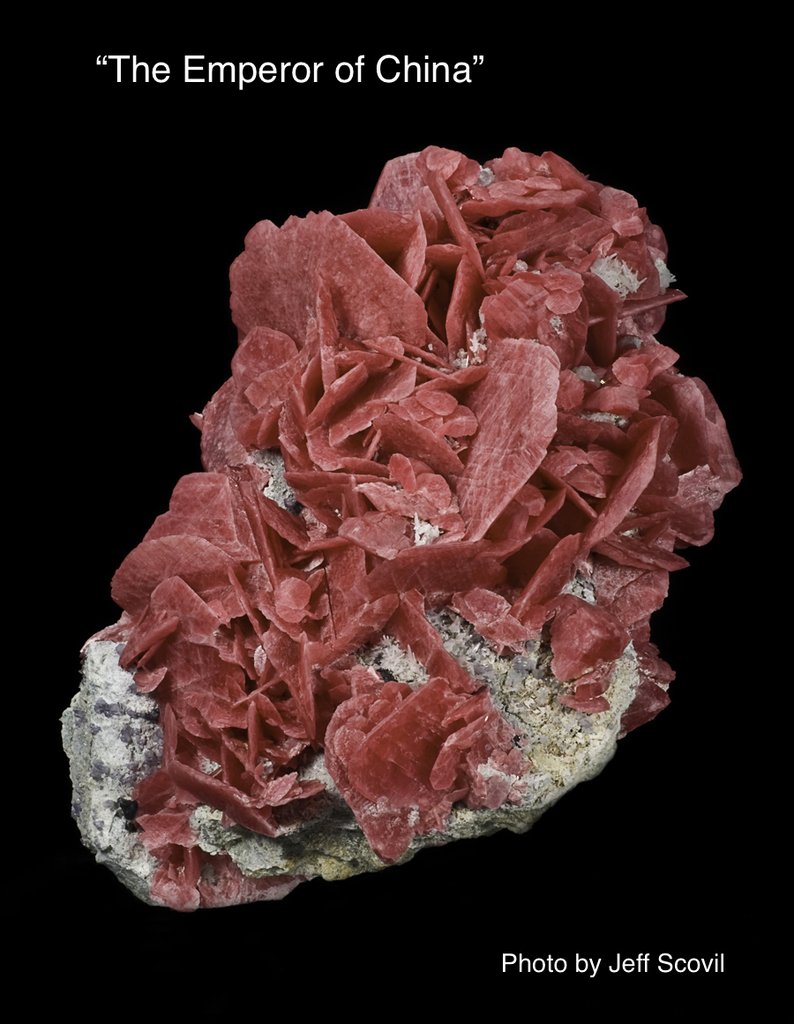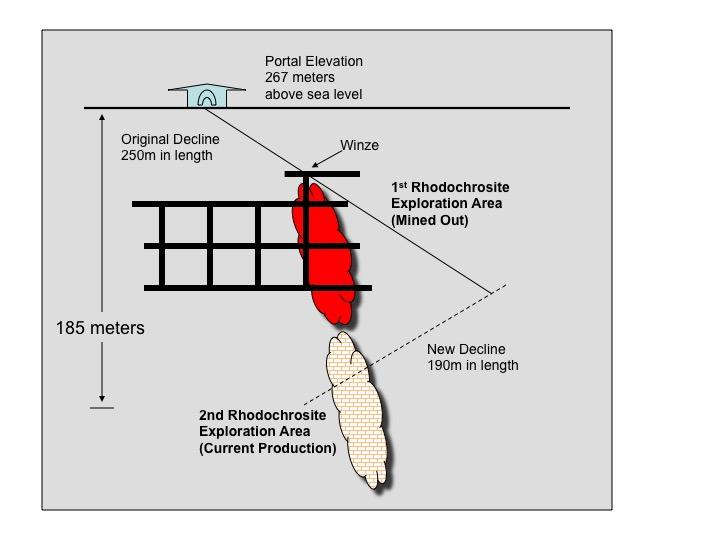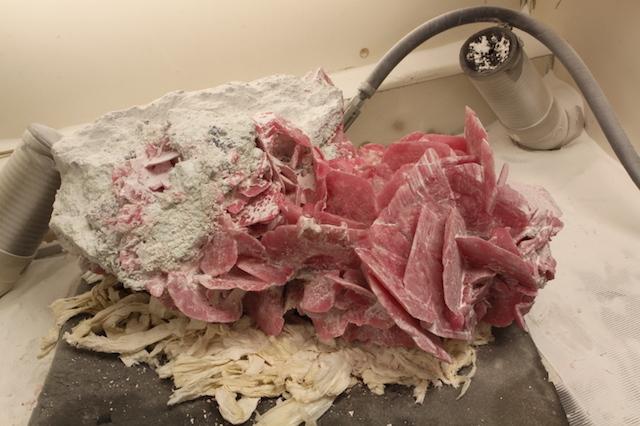Collector’s Edge Minerals, Inc. recognizes and thanks the Mineralogical Record for permission to use portions or all of their original article from the “Mineralogical Record”, Volume 42, Number 6, pp. 521-544. Contributing authors were Bryan Lees and Steve Behling, Collector’s Edge Minerals, Inc.; Dean Misantoni; Volker Luders and Rolf L. Romer, Helmholtz Centre Potsdam, GFZ German Research Centre for Geosciences; Pilar Lecumberri Sanchez, Department of Geosciences, Virginia Polytechnic and State University; and Paul Cory, Iteco, Inc. Collector’s Edge has made some additions and changes to the original article which are incorporated below.
Introduction
In 2007, The Collector’s Edge Minerals, Inc. (CEMI), under the direction of Bryan Lees, embarked on a new treasure hunt in China, initiating a challenging mining venture in the Guangxi Zhuang Autonomous Region, near the city of Wuzhou, to mine for a reported new occurrence of rhodochrosite. CEMI was able to successfully mine, discover and introduce to the mineral market, new World Class rhodochrosite mineral specimens.
When one thinks of premier rhodochrosite specimens, the first thing that may come to mind are the fabulous specimens discovered at the Sweet Home Mine, Alma, Colorado by Collector’s Edge Minerals, Inc. (CEMI) during the 1991 to 2005, particularly the “Alma King”, which now resides on permanent display at the Denver Museum of Natural History along with the “Denver Wall of Rhodochrosite”. It seemed at the time that nothing could rival these fabulous specimens.
However, from 2000 to 2006, rich-red and deep pink rhodochrosite specimens began trickling out of China. In June 2006, representatives of CEMI were invited to visit the site; and in the fall of 2007, Collector’s Edge formed a collaborative agreement with the mine owners of the Wutong mine to begin advanced mining operations for rhodochrosite specimens. CEMI brought with them advanced specimen recovery techniques and specialized mining equipment in order to improve the quantity and quality of the rhodochrosite specimens being recovered and also provided a formal geologic evaluation of the deposit to the mine owners.
Location
The Wutong mine is a small, underground mining operation located in the Guangxi Zhuang Autonomous Region, China, approximately 350 kilometers northwest of Hong Kong, and southeast of Guilin.
The closest town, Liubao, Cangwu County, Wuzhou Prefecture is approximately 361 km southeast of Guilin and about 24 kilometers from the mine. Wutong is reached via a dirt road that cuts through low, rolling tree-covered mountains. The road to the mine passes numerous small, terraced farms where water buffalo are in abundance!
A small farming village on the way to the Wutong Mine. Rural life in these villages is simple but the surrounding hills hide some fabulous treasures!
Local cuisine is simple but nutritious!
History
The Wutong polymetallic deposit was first discovered in 1958. The Wutong mine was operated exclusively for lead, zinc and silver almost all of its life. Government reserve evaluations concluded that the deposit contained 4,676 tons of lead, 3,555 tons of zinc, and 6.65 tons of silver (Wuzhou City Land Resources Dept. – Geological Assessment Report of the Wutong Lead-Zinc Mine).
Portal to the declined shaft at the Wutong mine; elevation 267 meters above sea level.
Ore carts exiting the declined shaft, principle access at the Wutong mine.
During 2000, the mineral markets in Guilin, Guangxi Zhuang A.R. and in Changsha, Hunan Province saw the first hints of a new locality for rich red and deep-pink rhodochrosite in China. From 2000 until early 2006, few dealers were certain (or would admit) to the actual source of these intriguing new specimens. During this time, the small number of new rhodochrosite specimens which made it to the Chinese mineral markets were attributed to either the Babu District, Hezhou Prefecture, Guangxi Zhuang Autonomous Region or Nandan, Hechi Prefecture.
Chinese mineral dealer in Motel room in Guilin with tantalizing rhodochrosite being offered for sale from an undisclosed locality.
A representative rhodochrosite specimen offered for sale in the period 2000-2006 from the undisclosed mine location. This is the kind of specimen that intrigued local Chinese representatives for Collector’s Edge and led to a determined search for the actual production locality.
Collector’s Edge Minerals had developed solid name recognition in China and owners of the Wutong mine, in June 2006, invited representatives of the Collector’s Edge to visit the mine to discuss a possible arrangement for specimen mining. The mine operation was utilizing a small ball mill and a six-cell flotation system to produce base metal concentrates and small amounts of silver, which were their primary products. Awareness of Wutong as the source of the new Chinese rhodochrosite was growing and the demand from Chinese mineral dealers for additional Wutong mine rhodochrosite specimens to sell was exploding.
Mine management began placing more emphasis on exploring for and recovering rhodochrosite mineral specimens and gem-rough. The mine began “stock-piling” the lead-zinc-silver ores in piles for future processing. Rhodochrosite had clearly become the Wutong mine’s most important product and the financial success of the mining venture would hinge upon finding more. The original ownership group needed to raise additional capital to enable a broadening and acceleration of the rhodochrosite search. A group of Changsha mineral dealers, led by Xie Ganyi, agreed to provide funding for this expanded mining effort in exchange for taking over majority mine ownership and operational responsibilities.
Bryan Lees, CEMI, first visited with the new mine owners in mid-2006, at their Changsha office. Upon arrival at the office he found a wonderfully dog-eared copy of the Mineralogical Record’s famous issue on the Sweet Home Mine (Volume 29, Number 4 / July-August 1998) that was proudly being passed around. The new mine owners were apparently quite familiar with the story of the Sweet Home Mine and, indeed, were using information contained in the magazine to formulate mining strategies. They expressed great interest in working with Collector’s Edge.
Collector’s Edge provided management direction for mineral specimen collection and preparation services. From Left: Graham Sutton (CEMI), Zhang Wei (Wutong mine), Zhang Min (CEMI), Peng Peng (Wutong mine), Qiao Han Yin (CEMI).
Collector’s Edge developed a collaborative working relationship with the new mine owners in autumn, 2007, as rhodochrosite specimen mining was moving forward with renewed vigor. Advanced specimen recovery techniques and specialized mining equipment were provided to Wutong by CEMI to improve the quantity and quality of the rhodochrosite specimens being recovered. CEMI provided geological expertise to do a detailed geologic study of the mine and determine the mineral sequence in the mine. CEMI also provided their own team of experienced miners for recovery of specimen pockets. It was also agreed by the mine’s new owners to utilize Collector’s Edge specimen preparation services in Golden, Colorado when important crystal pockets were encountered.
A major extension of the decline at the Wutong mine was undertaken. This new decline was directed to intersect the mineralized veins at depth in order to allow the miners to raise on the identified rhodochrosite veins. The extension of the decline took months of hard work, digging through country rock, and consumed a significant amount of available operating funds.
Wutong miners being lowered into mine shaft.
Wutong miners descending the mine shaft.
Collector’s Edge Mine Manager, Graham Sutton, being lowered down the winze on a “bosun’s chair” to reach the upper rhodochrosite workings.
Miners employing a diamond chain saw to extract a rhodochrosite pocket (2008).
In-situ pocket of rhodochrosite (2008).
Completing the new decline in the fall of 2009, miners at Wutong turned their attention to raising and drifting on the veins intersected by the decline. The first few months of exploration were discouraging. Miners were not encountering the quality or size of rhodochrosite veins predicted to be at depth based on their experiences in the upper workings.
Seam of rhodochrosite exposed in the mine.
Fortunately, in late 2009 and early 2010, a series of pockets were encountered making mineralogical history. In April 2010 an amazing crystal pocket was found yielding aesthetic pieces of gargantuan size. The top two pieces from this pocket were nicknamed “Emperor of China” and “Empress of China”.
The “Emperor of China”, the world’s largest crystallized rhodochrosite specimen. The specimen measures 40×60 cm and weighs 63.5 kilograms. The largest single crystal measures 22 centimeters across. Wutong Mine Partnership specimen.
The “Empress of China”, one of the world’s finest rhodochrosite specimens (39 cm across). Currently on display in a Chinese museum.
Mining efforts in the latter half of 2010 and the beginning of 2011 yielded few results. Only relatively modest crystal pockets were found since the bonanza of the “Empress” and “Emperor”. It is hard to foretell what the future will hold for the Wutong mine. The “feast or famine” nature of mining for rhodochrosite crystal pockets is always a technical and financial challenge.
Geology
Collector’s Edge conducted a study at the Wutong Mine in August 2006. The approach to the study followed lessons learned from the Sweet Home mining operation of the 1990’s. At the Sweet Home Mine, the first successful rhodochrosite discoveries came from understanding the relationships between vein structures, faulting and host rock types. It was hoped that similar relationships at the Wutong mine could be used to guide a rhodochrosite exploration program.
CEMI’s geologist, Dean Misantoni, records his observations of the geologic features
present on the lower levels of the original rhodochrosite workings at Wutong.
In the Wutong mine area, Cambrian-age sedimentary rocks have been tectonically disturbed by a series of complex synclinal and anticlinal folds. At the mine these rocks consist of dark gray to black siltstones and shales dipping steeply northeast, some sandstone, and a distinct, fine-trained, glassy, pale gray chert bed up to 50 cm thick. The chert bed is believed to be an important local control for the type of faulting and fracturing observed within the mineralized structures. At least one granitic intrusion of uncertain age was observed to crop out on the surface; this may represent a conformable sill which was subsequently folded, or more likely was intruded conformably along the steeply dipping fold limbs. U-Pb isotopic age dating of huebnerite indicates a mid-Cretaceous age for mineralization
The mineralized structure developed at the Wutong Mine crops out, or is exposed by exploration trenches, at elevations up to 350 meters on the hill above the mine. The lowest level of the mine (4th sublevel) is at 180 meters, giving a total vertical exposure of 170 meters (552 ft.). However, surface outcrops are highly oxidized and weathered. The vertical interval within the mine that exposes fresh rocks is from 230 meters (main mine level) down to 175 meters, for approximately 55 meters of vertical exposure.
The thin-bedded, clastic sediments (shales, siltstones, etc.) strike to the northwest and dip steeply to the northeast. The average strike and dip is N45oW, 78oNE. A previous geological study (Wuzhou City Land Resources Department, undated) suggested that the main mineralized fracture zone is along the axis, or hinge zone, of a syncline. However, since all measurements of the fault zone show bedding dipping steeply to the northeast, the hinge zone connecting to the opposing flank of the syncline must lie further to the northeast, and the actual fold must be very tight or V-shaped assuming that the plunge is sub-horizontal. The mineralized fracture zone is parallel or sub-parallel to the bedding, and up to 2 meters wide in mine exposures. At the level of the Wutong mine, the mineralization is stratiform, occupying a steep zone of slippage along bedding planes (like a deck of cards). Such movement would not normally be expected to create large openings, since there are many available planes of movement. The most important control, and the primary reason for the initial faulting in the structure, is the bedding in the hard, brittle chert. Notable is a strong set of features (early quartz-huebnerite veins, sulfide pods, and small open pockets) that are aligned sub-horizontally across the nearly vertical structure.
Simplified longitudinal section of the mine showing the first and second rhodochrosite
exploration areas and the inclined access shafts.
The conspicuous horizontal orientation of early quartz/huebnerite veins, small pockets and pods in this setting suggests that the early mineralization is of the “ladder vein” type, localized where a steeply dipping, competent unit (chert) is enclosed by less competent lithologies (graphitic shales, etc.). These mineralized sub-horizontal structures do not extend laterally outside of the fault zone.
The generalized three-stage paragenetic sequence is:
(1) Early quartz-huebnerite deposition associated with faulting, followed by galena-sphalerite-pyrite-chalcopyrite-rhodochrosite-purple fluorite
(2) Further faulting, followed by deposition of abundant, green to clear fluorite-apatite-calcite-barite. The late fluorite and calcite fill in the remaining open spaces in the brecciated zone and coats all earlier minerals locally.
(3) Native silver wires associated (uncommonly) with base metal-rhodochrosite pods and shiny, snow-white clays coating all of the species listed above.
At the conclusion of the mine study, Collector’s Edge provided geological observations and rhodochrosite exploration strategies to the mine owners.
Origin and Evolution of Mineralizing Fluids
The study of fluid origin and evolution played a critical role when Collector’s Edge was exploring for rhodochrosite pockets at the Sweet Home mine in Colorado during the 1990s. In 2009, in order to better understand the Wutong deposit and improve prospects for finding rhodochrosite, Collector’s Edge provided a comprehensive sample suite to Volker Luders of Potsdam, Germany for a fluid origin and evolution study.
Fluids (water, brines, steam and other gases) are significant factors in the evolution of ore deposits, playing crucial roles in the mobilization and transport of elements and in the dissolution and deposition of ore and gangue minerals. Furthermore, fluids may force open conduits (fractures in the rocks) when under high pressure, and then may close them by depositing minerals. Knowledge of the origin, temperature, pressure, and composition of the fluid phases(s) is an important prerequisite for understanding the conditions that led to the formation of ore deposits, and is thus one key sub-discipline in the quest for new mineral deposits.
Ore deposits can be of different origins: they may result from fluids that exsolved directly from magmas; from deeply circulating metamorphic fluids; or from sedimentary-basinal brines. Ore types, mineral suites, and vein textures found within ore deposits can be very similar, and yet the ore-forming fluids can be different in origin. Geochemical studies (e.g. isotope geochemistry, trace element distribution or fluid-inclusion studies) of minerals from ore deposits offer valuable clues to understanding the ore-forming processes.
Objectives
Mineral assemblages from the Wutong mine closely resemble those found at the Sweet Home mine in Colorado, and at first glance this resemblance suggests a similar fluid evolution. The Wutong and Sweet Home mines are Pb-Zn-Ag deposits of similar mineralogy; both were originally exploited for silver, and both produced gem-quality rhodochrosite. The Sweet Home mine is in the Colorado Mineral Belt, which includes several giant porphyry-molybdenum deposits that have been linked genetically to the Sweet Home deposit. By contrast, the genetic relationships of the Wutong mine are unknown. Therefore, the fluids responsible for the formation of the Wutong deposit have been studied by geochemical means, then compared with the Sweet Home fluids in order to understand similarities and differences between the mineralogies of the two deposits.
Fluid Inclusions
Fluid inclusions trapped in several generations of minerals at the Wutong deposit have preserved a good record of hydrothermal fluid evolution. Fluid inclusions are small droplets of fluid trapped inside mineral crystals. Primary fluid inclusions are droplets of the original mineral-forming fluids that were entrapped as the crystals grew (see Roedder, 1977). Secondary fluid inclusions form when those minerals area later fractured and then re-healed, trapping some of the surrounding fluid present at the time of fracture. Based on these criteria, and provided that the properties of the inclusions have not been reset (e.g. by leakage), primary fluid inclusions can reveal the conditions prevailing when their host minerals formed, whereas secondary fluid inclusions can reveal conditions at some time after crystallization. The temperature and salinity conditions indicated by secondary fluid inclusions may be similar to those evidenced by the primary inclusions in the same crystal, or they may be different.
All dominant minerals corresponding to the second depositional stage at Wutong contain fluid inclusions in well-defined fluid-inclusion assemblages, meaning groups of fluid inclusions that were all trapped at the same time (Goldstein and Reynolds, 1994). The thermometric results yielded by each fluid inclusion in an assemblage (independently of whether they are primary or secondary in origin) are consistent, indicating that the analyzed fluid inclusions are indeed representative of the initial conditions of entrapment.
The fluid inclusions analyzed at Wutong record two stages of mineralization: an early huebnerite-quartz stage and a sulfide stage. Early-stage fluids are preserved as primary fluid inclusions in post-huebnerite quartz, hereafter referred to as early quartz; these fluids show the temperature of crystallization (“homogenization temperature”) to have been about 200oC and the salinity to have been around 1 equivalent weight % NaCl. The early fluids probably represent a first, weak hydrothermal pulse in the mineralization history at Wutong. In contrast, the sulfide stage has left an extensive fluid record throughout its depositional history. Fluids related to this second stage of mineralization at Wutong became systematically cooler with time; the system evolved from 320-250oC (when sphalerite crystallized), to 300-280oC (when rhodochrosite formed), to 220-180oC (for quartz), and finally to 160-130oC (for fluorite, which formed last). Secondary inclusions in early quartz showing consistent salinity and temperature are related to healing of cracks by fluids from sulfide stage. The fluid salinities decreased during the precipitation of sphalerite-rhodochrosite-quartz from 6 to 0 weight % NaCl equivalent (wt % NaCl eq.). The decrease in temperature and salinity in the sulfide stage over time corresponds to the trend typical of a magmatic fluid source. Along such a trend, as the magma cools down and crystallizes, the salinity of the aqueous fluids derived from the magma decreases, and the source of heat moves deeper (so the temperature in a given area decreases). Fluorite, which formed at the end of the sequence and has a salinity peak of around 8-16 weight % NaCl eq., is an exception to the decreasing-salinity trend.
Evolution of homogenization temperature (a) and salinity (b) along the paragenesis at Wutong.
Syn-mineral fluid inclusions reflect the temperature and salinity range registered in primary fluid inclusions in that mineral while post-mineral is referred to fluids registered in secondary fluid inclusions. Syn-quartz fluid inclusions constitute the available fluid register for the early stage. Later fluid inclusions belong to the sulfide stage. Fluid temperature decreases consistently during the sulfide stage. Fluid salinity shows a decreasing trend during the sulfide stage with the exception of fluorite inclusions.
Considering the general pattern defined by fluid inclusions in other minerals, this peak in salinity could be due to an input of a different fluid with higher salinity, or to a phenomenon that concentrates the existing salt in the remaining fluid. Boiling, pressure changes in the magma chamber or mineral precipitation are feasible explanations for the late change in salinity of the fluid. When saline fluids boil, the liquid becomes increasingly saline as the lower-salinity vapor is removed. Thus the high-salinity inclusions found in fluorite suggest that boiling occurred after the rhodochrosite-sphalerite stage and during the quartz-fluorite stage. Early fluid inclusions in sphalerite have a high CO2 because it would have been lost upon boiling. Low CO2 content was observed in early quartz, sphalerite, and rhodochrosite but not in later quartz and fluorite. A similar behavior in terms of CO2 was observed at the Sweet Home mine, but the possibility of boiling was discarded (Reynolds, 1998) because there was no fluid-inclusion evidence of it (i.e. liquid-rich and vapor-rich inclusions did not co-exist). Although there is no petrographic evidence for boiling at the Wutong mine either, the late peak in salinity combined with the evolution of CO2 does point to boiling as a feasible hypothesis. The existence of boiling would indicate low-pressure conditions during mineral formation at Wutong, pointing to a shallow (epithermal) environment. Conversely, at Sweet Home the mineralization was deposited at a considerably deeper crustal level (Luders et al., 2009).
Conclusions on Fluid Origin and Evolution
Although the mineral paragenesis at Wutong shows similarities to that at Sweet Home, there are clear differences in the origin and evolution of the fluids. Ore formation at Wutong was related to a single pulse of magmatic fluids derived from melts in old Archaen upper-crustal rocks. The Sweet Home hydrothermal system, however, shows much more complex fluid evolutions (from magmatic-dominated fluids in the early mineralization stage to more meteoric fluids towards the end of mineralization), such that precipitation of ore began at considerably higher pressure and greater depth (at least 3 km). So it is clear that similar mineralogies can be the result of significantly different processes. The fairly simple evolution of a magma-generated hydrothermal fluid observed at the Wutong mine shows that a more complex hydrothermal history, as at the Sweet Home mine, is not a prerequisite for the formation of world-class rhodochrosite specimens.
Rhodochrosite: MnCO3
Wutong mine rhodochrosite occurs as pinkish-red to vibrantly cherry-red crystals exhibiting a wide range of crystal forms and crystal sizes. Some crystals show a simple rhombohedral habit, resembling crystals from the Sweet Home mine, and also rhombohedrons with rounded corners formed by stair-step faces. The rhombohedral crystals range in size from less than 1 mm to more than 6 cm on an edge.
April 2010 mining activity exposed the most amazing crystal pocket ever found at the Wutong mine, containing several exceptionally important rhodochrosite specimens ever discovered. The pocket yielded aesthetic matrix pieces of incredible size with individual crystals equaling the largest, collector-quality rhodochrosite crystals ever found. The two most extraordinary pieces from this incredible pocket were unveiled for the first time at the 2011 Tucson Gem and Mineral Show. These specimens were the most raved about and certainly the most highly photographed mineral specimens at the Tucson Show.
The second largest piece, and many say the most beautiful specimen from the pocket, is the “Empress of China”. This specimen is a cluster of lustrous, medium-red crystals of rhodochrosite to 19 cm across which have formed in the shape of a fully-blossomed flower. The specimen is large, measuring 33 cm tall by 39 cm across. The “Empress” is owned by a private Chinese collector and has been loaned to an institution in Nanjing, China and, as of March 2014 is on public exhibition.
A shipment of rhodochrosite specimens being received and inspected at Collector’s Edge warehouse.
Many specimens recovered from pockets at the Wutong mine, while extraordinary, required significant cleaning and preparation at the CEMI laboratory to reveal their incredible size and beauty.
The “Empress of China” prior to cleaning and trimming at the Collector’s Edge laboratory
in Golden, Colorado (2010).
“The Empress of China”, after preparation at the CEMI laboratory. Specimen is 33cm x 39cm with the largest crystal approximately 19cm across.
The following specimen, shown in stages of cleaning, was named the “Emperor of China”, and measures a whopping 60 cm tall and 40 cm across. A single, large rhodochrosite crystal on the specimen is 22 cm across. The dominant feature of this specimen is a huge, aesthetically beautiful, 360-degree rosette of rhodochrosite crystals (bigger than a basketball). The “Emperor” is still the property of the mine owners but is loaned to the Hunan Geological Museum.
Collector’s Edge laboratory manager, Robert Lorda, preparing the “Emperor of China” in Golden, Colorado (2010).
According to Robert Lorda, the “Emperor of China”, when received at the Collector’s Edge laboratory, weighed more than 65 kilos (137.5 lbs) and three technicians worked for about six weeks on the specimen to remove the calcite/clay/limonite overgrowth. The “Emperor of China” required no repairs or restoration, but the final weight was 63.5 kilos. The “Empress of China” was worked on solely by Robert Lorda and required almost 50 hours of work over about three months. A coating of calcite/clay/limonite was removed and eight repairs (assembling pieces back together) and several restorations (replacing significant pieces which were missing) were made.
Collector’s Edge technician, Craig Wibirt, working on the “Emperor of China” in Golden, Colorado (2010).
It can be stated, without exaggeration that the “Emperor” and “Empress”
rhodochrosites are world-class, “Iconic” mineral specimens, of unique character and quality, able to stand shoulder to shoulder with the finest mineral specimens ever found.
The “Empress of China” displayed in the Collector’s Edge Minerals, Inc. booth at the
Tucson Gem and Mineral Show (2011).
Bryan Lees, President of CEMI (left) and the late Rock Currier, owner of Jewel Tunnel Imports, posing next to display of the “Emperor of China” rhodochrosite in Tucson (2011).
Medium-red, discoidal rhodochrosite crystals with pale blue dodecahedral fluorite crystals and quartz, 18 cm.
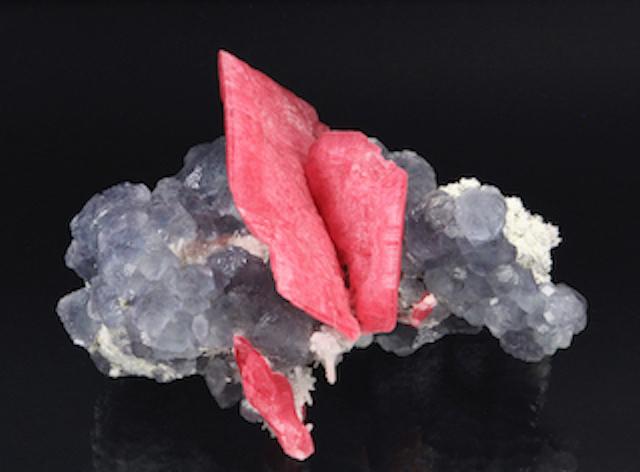
“The Lips”, a rhodochrosite/fluorite specimen from the November 2009 pocket. Width of specimen is approximately 17cm with the largest crystal 11cm.
Another incredible rhodochrosite/fluorite specimen nicknamed “The Blade”, 25 cm.
A spectacular specimen from the “Emperor Pocket” measuring 15x16x19 cm.
Tightly packed cluster of rhodochrosite crystals, 1.5 cm.
Rhombohedral crystals of cherry-red rhodochrosite to 2.5 cm on edge associated with vibrantly violet-colored fluorite and kutnohorite.
Other Minerals
Acanthite: Ag2S
Acanthite and native silver are the primary silver ores at the Wutong mine. Acanthite is rarely seen as collector-quality specimens; the crystals tend to be highly solution-etched to completely corroded. The largest individuals observed are in the 5 to 10-cm range.
Acanthite with wire silver. Field of view is 2 cm.
Barite: BaSO4
White, lustrous, bladed barite crystals to 6 cm across have been found sparingly at the Wutong mine, most commonly associated with cubic crystals of purple fluorite and rhombohedral rhodochrosite crystals. Some barite blades are overgrown by microcrystals of quartz.
Calcite: CaCO3
White, massive calcite appears as a vein-filling gangue mineral deposited during the final phase of mineralization at the Wutong mine.
Chalcopyrite: CuFeS2
Chalcopyrite is occasionally seen as well-formed, brassy crystals to 5 mm, in some cases as epitactic overgrowths on sphalerite and other sulfide minerals.
Chalcopyrite crystals to 4mm with reddish-pink rhodochrosite, fluorite
and quartz.
Fluorapatite: Ca5(PO4)3F
Fluorapatite is occasionally seen as well-formed, highly lustrous, colorless to pale pinkish purple, striated, prismatic crystals terminated by the basal pinacoid. The mineral is intimately associated with rhodochrosite crystals and fluorite. Fluorapatite crystals normally range in size from microscopic to 5 mm, and exceptionally to more than 1 cm.
Fluorapatite crystals to 1 cm with rhodochrosite and fluorite.
Fluorite: CaF2
Sharp, lustrous crystals of fluorite are abundant in the Wutong mine, predominantly as cubes, truncated cubes, cuboctahedrons, and truncated octahedrons ranging in size from less than 1 mm to 6 cm. Fluorite from the mineralization pulse associated with rhodochrosite-sulfide formation tends to be in smaller crystal sizes (less than 1 mm to 3 cm), with colors ranging from sea-green to bluish purple, gray-blue and purple. Fluorite that was deposited during the second mineralization phase is primarily pale green to colorless, in crystals up to 6 cm across
Medium-purple fluorite octahedron, 3 cm on edge, on a matrix of milky
Quartz crystals to 2.5 cm.
Galena: PbS
Galena is occasionally found as lustrous, steel-gray cubic to cuboctahedral crystals reaching 1 cm across.
Solution-etched crystals of galena to 1 cm associated with rhodochrosite
and pyrite.
Huebnerite: Mn2+WO4
Very rarely observed in specimens from the Wutong mine, huebnerite crystallized before the pulse of mineralization that deposited the rhodochrosite and the sulfides. The crystals look remarkably similar to those from the Sweet Home mine; that is, they are long, narrow, reddish brown blades. Many Wutong huebnerite specimens are associated with lustrous, colorless to milky quartz crystals.
Highly lustrous, reddish brown, elongated blades of huebnerite to 3.5 cm with
doubly-terminated quartz crystals to 7 mm.
Kutnohorite: Ca(Mn2+,Mg,Fe2+)(CO3)2
Kutnohorite is found rarely as attractive, pale pink, divergent sprays of elongated crystal clusters composed of hundreds of tiny, stacked rhombohedra. More commonly kutnohorite appears as a late-stage, white to pale pink, crystalline coating partially or completely covering rhodochrosite crystals.
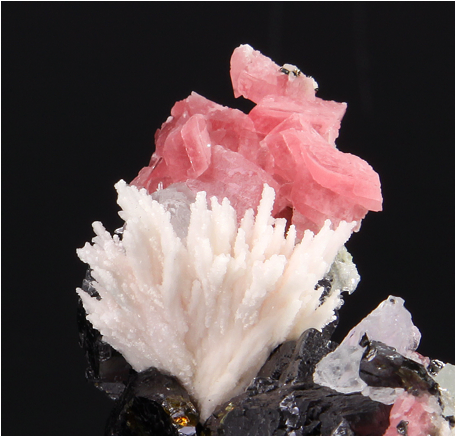
An attractive spray of pale pink kutnohorite crystals, 1.4 cm, with medium-pink
rhodochrosite rhombohedrons and sphalerite.
Pyrite: FeS2
Pyrite is ubiquitous and well crystallized at the Wutong mine. It occurs abundantly as bright, small crystals, (microscopic to several millimeters) disseminated throughout the rhodochrosite-bearing veins. Pyrite also forms sharp, highly lustrous, deeply to shallowly striated pyritohedrons and cubes associated with rhodochrosite, fluorite, quartz and other collector species in open vugs.
Bright, brassy, pyritohedral crystal of pyrite, 3 cm, on pale green fluorite.
Quartz: SiO2
Quartz occurs abundantly as small (1 mm to 3 cm), prismatic, water-clear to milky crystals. Late-forming quartz occasionally crystallizes as colorless to milky, tabular crystals, some exhibiting “faden” lines. Quartz is both an early and late-forming mineral in the deposit.
Silver: Ag
Rarely seen as “collector-grade” specimens at Wutong, silver occurs as thin wires and “nests” of wires intimately associated with acanthite. Silver and acanthite were apparently more abundant at the top of the lower stope in the original (pre-2006) workings.
A tightly packed cluster of wire silver with minor acanthite, 5 cm.
Sphalerite: ZnS
One of the most abundant sulfide minerals at the Wutong mine, sphalerite typically forms in highly lustrous, twinned crystals ranging from less than1 mm to 2 cm. Wutong sphalerite crystals have a high iron content and consequently are black and opaque.
A small cabinet-size cluster of well-formed sphalerite crystals, with individuals to 2 cm.
Pyrite crystals averaging 1 mm have crystallized on the sphalerite crystal surfaces.
Gemstones
Flawless faceted stones reaching nearly 30 carats in weight were cut from the early Wutong mine production. But despite this early production, large gem-quality crystals have since proven to be just as rare there as at the Sweet Home mine. Production in 2010 and 2011 yielded few faceted stones over ten carats.
Four faceted gemstones of rhodochrosite, ranging in size from 10.67 carats to 29.56 carats.
The purplish-red Wutong mine faceted rhodochrosite shown above show incredible color and brilliance. These gemstones are perfect for pendants and earrings. Rhodochrosite not suitable for faceting can also be fashioned into cabochons or other polished forms suitable for use in jewelry or rare gemstone collections.
If you are interested in more information about rhodochrosite gemstones, please contact our gemstone marketing representative, Paul Cory, of ITECO, Inc. at 614-785-0450, or visit ITECO’s website at www.itecoinc.com.
Current Status
In the summer of 2011 the Wutong mine was placed on a “care and maintenance” basis. The lower levels of the mine have since flooded. No specimen mining has taken place since that time and none are currently planned.
References
Collectors Edge Minerals Inc. recognizes and thanks the Mineralogical Record for permission to use portions or all of their original article from the “Mineralogical Record”, Volume 42, Number 6, pp. 521-544. Contributing authors were Bryan Lees and Steve Behling, Collector’s Edge Minerals, Inc.; Dean Misantoni; Volker Luders and Rolf L. Romer, Helmholtz Centre Potsdam, GFZ German Research Centre for Geosciences; Pilar Lecumberri Sanchez, Department of Geosciences, Virginia Polytechnic and State University; and Paul Cory, Iteco, Inc.
GOLDSTEIN, R.H., and REYNOLDS, T.J. (1994) Systematics of fluid inclusions in diagenetic minerals. SEPM Short Course notes, 31.
HOEFS, H. (1978) Stable Isotope Geochemistry. Springer-Verlag, Berlin, 241 p.
LUDERS, V., ROMER, R.L., GILG H.A., BODNAR, R.J., PETTKE, T., and MISANTONI, D. (2009) A geochemical study of the Sweet Home Mine, Colorado Mineral Belt, USA: hydrothermal fluid evolution above a hypothesized granite cupola. Mineralium Deposita, 44, 415-434.
MISANTONI, D. (2006) Summary of geologic evaluation of the Wutong Mine, Guangxi Province, China. Unpublished internal report, Collector’s Edge Minerals, Inc.
MOORE, T., LEES B.K., WENRICH, K.J., VOYNICK, S., MURPHY, J.A., HURLBUT, J.F., REYNOLDS, T.J., AUMENTE, R., MISANTONI, D. and SILBERMAN, M.L. (1998) The Sweet Home mine. Mineralogical Record, 29, 6-153.
REYNOLDS, T.J. (1998) Ancient fluids at the Sweet Home mine, Mineralogical Record, 29, 127-132.
ROEDDER, E. (1977) Fluid inclusions as tools in mineral exploration. Economic Geology, 72, 503-525.
WENRICH, K.J., and AUMENTE-MODRESKI, R. (1998) Crystal chemistry of minerals from the Sweet Home mine. Mineralogical Record, 29, 132-143.
WUZHOU CITY LAND RESOURCES DEPARTMENT (UNDATED) Geological assessment report of the Wutong Lead-Zinc Mine in CangWu County, Guangxi Province.

